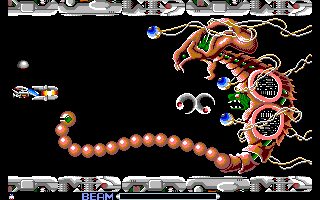Nemesis 2 is a side-scrolling shoot-em-up developed by Konami for the MSX computer system and released in 1987. Known as Gradius 2 in Japan, the game represents Konami's ambitious attempt to create a console-exclusive entry in their acclaimed space shooter series, taking full advantage of the MSX platform's capabilities.
Set in the distant future, players pilot the Vic Viper starfighter through a series of increasingly hostile alien worlds, each presenting unique environmental challenges and enemy formations. The game follows the traditional Gradius formula of collecting power capsules to enhance the ship's weaponry and defensive systems, but introduces several innovative elements that distinguish it from both its predecessor and contemporaries like R-Type or Salamander.
The visual presentation showcases impressive attention to detail that pushes the MSX hardware to its limits. The backgrounds feature remarkable depth with gradient shadows and atmospheric effects that create genuine visual interest beyond simple scrolling backdrops. Animated environmental elements bring the alien worlds to life - pods rising ominously from planetary surfaces, giant flames spewing red-hot stones across the screen, and organic cilia on the living planet's surfaces that wiggle back and forth with disturbing realism. These details create an immersive sense of place that many shoot-em-ups of the era failed to achieve.
The technical achievement becomes even more impressive when considering the game's ability to handle multiple objects simultaneously on screen. While this does cause occasional slowdown, the fact that the MSX can render complex enemy formations alongside detailed backgrounds and weapon effects represents a programming tour de force that rivals more powerful arcade hardware.
The level design demonstrates remarkable creativity that sets Nemesis 2 apart from more straightforward horizontal shooters. The Ancient Planet, Living Planet, and Fortress Planet stand out as particularly inspired creations that allow players to actively modify their environment through strategic shooting. The ability to destroy supporting columns and watch the platforms they support collapse, opening new pathways through levels, adds a puzzle-solving element rarely seen in the genre. This environmental interaction creates multiple routes through stages, encouraging exploration and replay in ways that linear shooters like Darius or Thunder Force don't typically offer.
The weapon system presents another unique aspect that expands beyond the traditional Gradius power-up structure. While maintaining the familiar capsule collection mechanics, Nemesis 2 introduces obtainable weapons with distinct characteristics that significantly impact gameplay strategy. Each weapon type offers different advantages for specific situations, requiring players to consider their loadout choices more carefully than in most shoot-em-ups where weapon progression follows a predetermined path.
The game's difficulty curve strikes an interesting balance between accessibility and challenge. Unlike the punishing difficulty of Gradius III or the overwhelming bullet patterns of later entries, Nemesis 2 provides a more measured progression that allows players to appreciate the environmental details and experimental weapon mechanics without constant frustration. This approach makes the game more welcoming to newcomers while still providing sufficient challenge for experienced players.
The sound design effectively complements the visual spectacle with memorable musical themes that capture the sci-fi atmosphere while maintaining the energetic pace essential to the genre. The weapon effects and enemy destruction sounds provide satisfying audio feedback that enhances the shooting experience without overwhelming the musical score.
Nemesis 2's MSX exclusivity unfortunately limited its audience compared to arcade or console releases, but this focus allowed Konami to create something genuinely unique within their shoot-em-up catalog. The game serves as both an impressive technical showcase for the MSX platform and a creative experiment that introduced environmental interaction and weapon variety elements that would influence later entries in the series.
For fans of the Gradius series or horizontal shooters in general, Nemesis 2 represents a fascinating glimpse at what the genre could achieve when developers prioritized environmental storytelling and interactive level design alongside traditional shooting mechanics.













